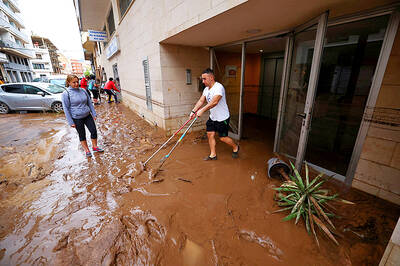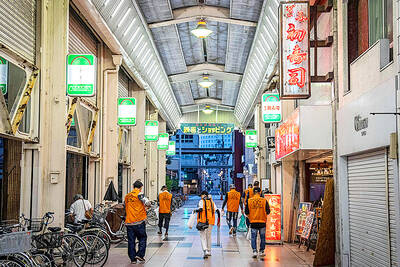The catastrophic death toll in Asia caused by a massive tsunami might have been reduced had India and Sri Lanka been part of an international warning system designed to warn coastal communities about potentially deadly waves, scientists say.
At least 10,000 people in India and Sri Lanka were among the nearly 23,000 killed after being hit by walls of water triggered by a tremendous earthquake early on Sunday off Sumatra.
The warning system is designed to alert nations that potentially destructive waves may hit their coastlines within three to 14 hours. Scientists said seismic networks recorded Sunday's massive earthquake, but without wave sensors in the region, there was no way to determine the direction a tsunami would travel.
A single wave station south of the earthquake's epicenter registered tsunami activity less than 60cm high heading south toward Australia, researchers said.
The waves also struck resort beaches on the west coast of Thailand's south peninsula, killing hundreds. Although Thailand belongs to the international tsunami-warning network, its west coast does not have the system's wave sensors mounted on ocean buoys.
The northern tip of the earthquake fault is located near the Andaman Islands, and tsunamis appear to have rushed eastward toward the Thai resort of Phuket on Sunday morning when the community was just stirring.
"They had no tidal gauges and they had no warning," said Waverly Person, a geophysicist at the National Earthquake Information Center in Golden, Colorado, which monitors seismic activity worldwide. "There are no buoys in the Indian Ocean and that's where this tsunami occurred," he said.
The tsunami was triggered by the most powerful earthquake recorded in the past 40 years.
The earthquake, whose magnitude was a staggering 9.0, unleashed walls of water more than two storeys high to the west across the Bay of Bengal, slamming into coastal communities 1,600km away. Hours after the quake, Sumatra was struck by a series of powerful aftershocks.
Researchers say the earthquake broke on a fault line deep off the Sumatra coast, running north and south for about 965km or as far north as the Andaman and Nicobar islands between India and Myanmar.
"It's a huge rupture," said Charles McCreery, director of the Pacific Tsunami Warning Center near Honolulu. "It's conceivable that the sea floor deformed all the way along that rupture, and that's what initiates tsunamis."
Tsunamis as large and destructive as Sunday's typically happen only a few times in a century.
A tsunami is not a single wave, but a series of traveling ocean waves generated by geological disturbances near or below the ocean floor. These waves can race across the ocean like the crack of a bullwhip, gaining momentum over thousands of kilometers.
Most tidal waves are triggered by earthquakes and volcanoes.

Police in China detained dozens of pastors of one of its largest underground churches over the weekend, a church spokesperson and relatives said, in the biggest crackdown on Christians since 2018. The detentions, which come amid renewed China-US tensions after Beijing dramatically expanded rare earth export controls last week, drew condemnation from US Secretary of State Marco Rubio, who on Sunday called for the immediate release of the pastors. Pastor Jin Mingri (金明日), founder of Zion Church, an unofficial “house church” not sanctioned by the Chinese government, was detained at his home in the southern city of Beihai on Friday evening, said

Floods on Sunday trapped people in vehicles and homes in Spain as torrential rain drenched the northeastern Catalonia region, a day after downpours unleashed travel chaos on the Mediterranean island of Ibiza. Local media shared videos of roaring torrents of brown water tearing through streets and submerging vehicles. National weather agency AEMET decreed the highest red alert in the province of Tarragona, warning of 180mm of rain in 12 hours in the Ebro River delta. Catalan fire service spokesman Oriol Corbella told reporters people had been caught by surprise, with people trapped “inside vehicles, in buildings, on ground floors.” Santa Barbara Mayor Josep Lluis

The Venezuelan government on Monday said that it would close its embassies in Norway and Australia, and open new ones in Burkina Faso and Zimbabwe in a restructuring of its foreign service, after weeks of growing tensions with the US. The closures are part of the “strategic reassignation of resources,” Venezueland President Nicolas Maduro’s government said in a statement, adding that consular services to Venezuelans in Norway and Australia would be provided by diplomatic missions, with details to be shared in the coming days. The Norwegian Ministry of Foreign Affairs said that it had received notice of the embassy closure, but no

A missing fingertip offers a clue to Mako Nishimura’s criminal past as one of Japan’s few female yakuza, but after clawing her way out of the underworld, she now spends her days helping other retired gangsters reintegrate into society. The multibillion-dollar yakuza organized crime network has long ruled over Japan’s drug rings, illicit gambling dens and sex trade. In the past few years, the empire has started to crumble as members have dwindled and laws targeting mafia are tightened. An intensifying police crackdown has shrunk yakuza forces nationwide, with their numbers dipping below 20,000 last year for the first time since records